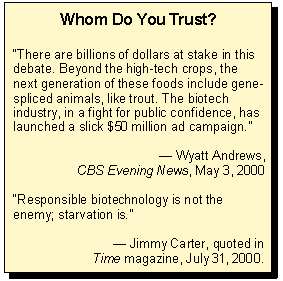Apart from a tiny minority of Americans who shop exclusively at
organic whole food markets and who never dine out, all of us have
been eating genetically-modified foods for years. In recent months,
however, the controversy over whether some hidden dangers might lurk
inside ears of corn, soybeans, and other basic agricultural products
that have had their genes spliced has found its way from Europe to
the New World, and into the mainstream media.
 As
with most so-called "consumer" issues, the media focus most of their
skepticism on corporate interests while critics are painted as
selfless public-interest advocates. In the case of
genetically-modified foods, the media have given a great deal of
airtime juxtaposing the corporations that have invested in
researching and developing improved foods with groups such as the
Center
for Food Safety, a gang of leftist lawyers who have filed
numerous lawsuits against government and business.
As
with most so-called "consumer" issues, the media focus most of their
skepticism on corporate interests while critics are painted as
selfless public-interest advocates. In the case of
genetically-modified foods, the media have given a great deal of
airtime juxtaposing the corporations that have invested in
researching and developing improved foods with groups such as the
Center
for Food Safety, a gang of leftist lawyers who have filed
numerous lawsuits against government and business.
Itís a media paradigm that tilts the debate against business. On
the May 3 CBS Evening News, for example, reporter Wyatt
Andrews framed it this way: "There are billions of dollars at stake
in this debate. Beyond the high-tech crops, the next generation of
these foods include gene-spliced animals, like trout. The biotech
industry, in a fight for public confidence, has launched a slick $50
million ad campaign." Slick advertisers vs. consumer groups ó whom
do you trust?
Additionally, this approach paints the two sides as debating a
product that some people say is risky and that others (namely, the
ones who will make the profits) say is not. A consumer might wonder
why any risk, even if it is purely hypothetical and so far unproven,
is either necessary or desirable?
Thatís one reason why Timeís July 31 cover story, written
by J. Madeleine Nash, was so refreshing: she actually explained the
potential pay-off ó to society, not just to big business ó of
genetically-modified foods. Nash described one scientistís efforts
to use genetic modification to create a variety of rice that would
be more nutritional than conventional rice. Hereís an excerpt:
"At first, the grains of rice that [genetic scientist] Ingo
Potrykus sifted through his fingers did not seem at all special,
but that was because they were still encased in their dark,
crinkly husks. Once those drab coverings were stripped away and
the interiors polished to a glossy sheen, Potrykus and his
colleagues would behold the seeds' golden secret. At their core,
these grains were not pearly white, as ordinary rice is, but a
very pale yellow ó courtesy of beta-carotene, the nutrient that
serves as a building block for vitamin A.
"Potrykus was elated. For more than a decade he had dreamed
of creating such a rice: a golden rice that would improve the
lives of millions of the poorest people in the world. He'd
visualized peasant farmers wading into paddies to set out the
tender seedlings and winnowing the grain at harvest time in
handwoven baskets. He'd pictured small children consuming the
golden gruel their mothers would make, knowing that it would
sharpen their eyesight and strengthen their resistance to
infectious diseases.
"And he saw his rice as the first modest start of a new green
revolution, in which ancient food crops would acquire all manner
of useful properties: bananas that wouldn't rot on the way to
market; corn that could supply its own fertilizer; wheat that
could thrive in drought-ridden soil....
"[Golden rice is] the first compelling example of a
genetically engineered crop that may benefit not just the
farmers who grow it but also the consumers who eat it. In this
case, the consumers include at least a million children who die
every year because they are weakened by vitamin-A deficiency and
an additional 350,000 who go blind."
To be sure, Nash included all of the typical criticisms of
genetically-modified food, including references to "Frankenfood" (a
scare term conjured by the European press), and quoted
representatives of the far-left Union of Concerned Scientists and
the Environmental Defense Fund. But she also included a fair
description of the positive potential of improved food products, and
itís more than the conventional media routine about more profits for
big corporations. The ultimate beneficiary could be all of mankind;
at one point, Nash quoted former President Jimmy Carter:
"Responsible biotechnology is not the enemy; starvation is."
Kudos to J. Madeleine Nash for eschewing business-bashing and
providing a balanced discussion of this important issue. You can
read her full article, "Grains
of Hope," on Timeís website.
ó Rich
Noyes












 As
with most so-called "consumer" issues, the media focus most of their
skepticism on corporate interests while critics are painted as
selfless public-interest advocates. In the case of
genetically-modified foods, the media have given a great deal of
airtime juxtaposing the corporations that have invested in
researching and developing improved foods with groups such as the
As
with most so-called "consumer" issues, the media focus most of their
skepticism on corporate interests while critics are painted as
selfless public-interest advocates. In the case of
genetically-modified foods, the media have given a great deal of
airtime juxtaposing the corporations that have invested in
researching and developing improved foods with groups such as the
